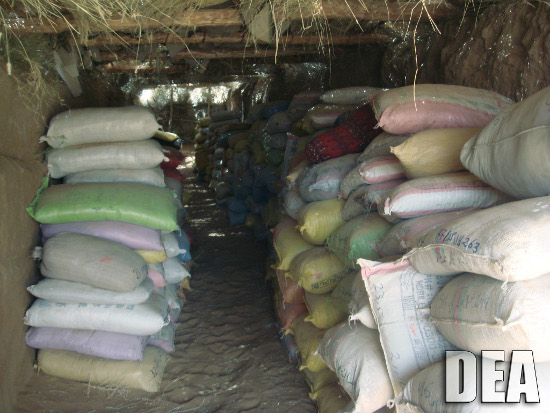Kandahar drug bust: narco-penetration of the state

|
| Sacks of drugs seized during Operation Alabtross II in the Spin Boldak region of Kandahar. DEA Photo. |
With an increased focus on the narco-insurgent linkages in Afghanistan, NATO and US forces are actively targeting drug refinement workshops (routinely and inaccurately described as “laboratories”), drug shipments, and “nexus-targets,” those involved in both insurgent activity like IEDs and ambushes and also the narcotics industry (see Haji Adam). But what is most often missed is the critical relationship between narco-traffickers and traders with corrupt Afghan government officials, usually identified vaguely by press accounts as “local commanders,” “strongmen,” or “warlords.”
At last, a report over at Danger Room sheds some much needed light on this critical relationship. According to the report, a US drug raid in Kandahar Province on July 18 turned up a huge stash of opium and hashish, of which Kandahar is the number two producer of both out of Afghanistan’s 34 provinces. The operation began shortly after Border Police commander Shar Shahin was “lured” to Kandahar Airfield and arrested along with his five bodyguards. With Shahin in custody, a 37-man task force made up of DEA-FAST team personnel and members of Afghanistan’s National Interdiction Team flew to the volatile Argestan district and conducted the successful interdiction operation.
Last year, the world’s largest drug seizure ever recorded took place during Operation Alabtross II in the Spin Boldak region of Kandahar. DEA FAST members and TF-333 commandos, Afghanistan’s elite special counternarcotics forces mentored by British SBS personnel, raided a large hashish drying depot in the desert, uncovering a staggering 262-metric ton* haul of Afghan hash. That is the equivalent weight of 30 London style double-decker buses.
The storage bunkers were so vast that British Harriers were called in to drop 1000-lb. munitions to “crack open” the bunkers so the hash could be doused with petrol and lit on fire by ground teams. Unconfirmed reports have linked the border police commander in Spin Boldak, Major General Abdul Razziq, to the vast hash-depot in the desert (Razziq was the target of a suicide attack September 2008).
Most recently, an Afghan National Army commander and an officer from Wardak Province were convicted and sentenced by the Criminal Justice Task Force (CJTF) court on Aug. 13 for narcotics trafficking, according to a report filed by Pajhwok News. These two convicted ANA officers, along with Shar Shahin and his men are part of a growing list of Afghan government officials, border police commanders, and highway police officers being arrested and charged by the CJTF for narco-trafficking.
*Some other reports indicate it was a 237-ton haul.
